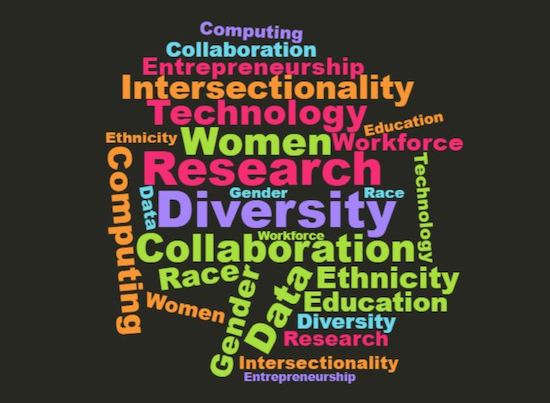Created with Word Clouds
The
Women of Color in Computing Researcher/Practitioner Collaborative connect diversity, data, and tech from an intersectional perspective.

Created with Word Clouds
This collaborative effort aims to nurture research on women of color in computing across various stages, including:
- higher education
- the tech workforce
- entrepreneurship and venture capital
In 2018, a report resulted from this effort: "Data Brief: Women of Girls and Color in Computing." The report tells the following story of a field in which disparity and disproportion are pervasive.
Technology
Technology, global in scope, can amplify economic growth. Integral parts of the tech workforce include computing and information technology occupations. These occupations offer substantial economic benefit to their holders.
But, the computing sector has a problem. This sector's demographic makeup skews the non-representativeness when compared to the United States' diversity.
Lack of diversity underpins a need to extend tech-specific occupational opportunities to groups at society's margins and build a workforce with diverse talent and potential.
For example, "Black and Latinx women . . . are the fastest growing group of entrepreneurs in the United States."
But, vast underrepresentation siloes this potential. So, more needs to be done to unlock diverse talent.
Intersectionality
Enhancing inclusion and opportunity for marginalized and diverse groups requires a nuanced perspective.
In this context, considering the interlock between gender and racial/ethnic background is critical.
Intersectionality looks at how forces like racism and sexism overlap to impact individuals, groups, and communities.
For example, intersectionality may involve uncovering diversity issues by looking at college enrollment statistics for various combinations of race/ethnicity backgrounds and gender identities: White men, Latinx women, persons who identify as Black and non-binary, and other combinations.
Early Experiences
An intersectional perspective can expose disparities that start early in the life course.
Factors like low participation in high school advanced placement computer science classes among Black, Latinx, and Native American girls—coupled with zero Black and Latinx girls even being in such courses in 13 states�"may set the stage for disparity at later points in life.
The Post-Secondary Level
A look at post-secondary education completion rates unveils the sequelae of early disparity.
The disconnection between women of color's post-secondary enrollment versus computer science bachelor's degree completion is stark.
Respectively, these rates are:
- Eight percent versus three percent for Black women
- Ten percent versus two percent for Latinx women
Disproportion at the post-secondary level can trigger decreased participation in the tech workforce.
The Workforce
Decreased participation is a reality.
National Science Foundation data show that "among all women employed in computer and information science occupations, 56% are White women, 32% are Asian women, 7% are Black women[,] and 5% are Latinx women."
Silicon Valley magnifies racial/ethnic and gender disparities: "In Silicon Valley, men constitute 70% of the workforce, Asian and White women comprise a combined 26% of the professional workforce, while Black, Latinx, and Native American/Alaskan Native women each constitute 2% or less."
The Effects of Disparity on Building from the Ground Up
Racial/ethnic and gendered disproportion in professional and leadership positions may extend into entrepreneurship and venture capital—as well as broader patterns of social and economic well-being:
Without the participation of women of color in the creation of new technology enterprises, products[,] and solutions, women of color will be excluded from opportunities to develop and invest in products intended to solve pressing challenges facing diverse communities, develop wealth in salary, equity, and investment returns, and decrease widening inequality.
Moving Forward with Research and Data
Cultivating a "tech ecosystem" conducive to women of color's success in computing requires a transformational approach—one that first builds an empirical and theoretical foundation through data and research.
Strengthening the base of research and data may prove vital in creating a context that holistically does the efforts of marginalized and diverse communities justice.
Julio Montanez is a former staff writer for WITI (Women in Technology International). He has a bachelor's degree in political science and sociology from the University of Central Florida. Julio hopes to one day be a university professor.
Opinions expressed by the author are not necessarily those of WITI.
Are you interested in boosting your career, personal development, networking, and giving back? If so, WITI is the place for you! Become a WITI Member and receive exclusive access to attend our WITI members-only events, webinars, online coaching circles, find mentorship opportunities (become a mentor; find a mentor), and more!
Founded in 1989, WITI (Women in Technology International) is committed to empowering innovators, inspiring future generations and building inclusive cultures, worldwide. WITI is redefining the way women and men collaborate to drive innovation and business growth and is helping corporate partners create and foster gender inclusive cultures. A leading authority of women in technology and business, WITI has been advocating and recognizing women's contributions in the industry for more than 30 years.
The organization delivers leading edge programs and platforms for individuals and companies -- designed to empower professionals, boost competitiveness and cultivate partnerships, globally. WITI’s ecosystem includes more than a million professionals, 60 networks and 300 partners, worldwide.
WITI's Mission
Empower Innovators.
Inspire Future Generations.
Build Inclusive Cultures.
As Part of That Mission WITI Is Committed to
Building Your Network.
Building Your Brand.
Advancing Your Career.


Comments